SOME PIDDLEHINTON PEOPLE
- The Astell family
- John Baverstock Knight
- The Belgrave family
- The Churchill Family
- The Cosh Family
- The Dyke family
- The Green Family
- The Gregory Family
- The Groves Family
- The Jeanes Family
- The Lovelace family
- Thomas Meggs
- The Riggs Family
- PC 89 James Searley
- The Tory Family
- The Way Family
- Ann Winzer
- The Woodland Family
Our census records show that there are a few families who have lived in the village since 1841 and still have descendants living here today. These are the Coshes, Jeanes, Lovelaces, and Ways and, until 1976, the Churchills at Muston who have lived here longest of all. Other families have been in the village for more than one generation including Belgraves, Damens, Dykes, Gerrards, Gregorys, Greens, Hansfords, Murphys, Reids, Riggs, Saints and Torys.
We have found records of others who lived in the village in earlier times who led interesting lives. There must be many more.
This chapter gives a few details of some of these families in alphabetical order. Some of the information is duplicated from elsewhere in the book.

The Coach house at West Lodge which General and Mrs Astell built in 1898 to celebrate their Golden Wedding. Its striking clock is the only one in the village.
Major and Mrs Astell bought West Lodge in 1862 and altered it extensively, adding a conservatory leading to a new front door on the east side of the house.
In 1871 the census records Major Astell JP and his Irish wife, Harriette, living in the house with their son and four daughters, an American governess, a Swiss ladies' maid, a parlourmaid, a housemaid and a kitchenmaid. The gardener, the coachman, and their families lived in West Lodge Cottages. Mrs Astell was very eccentric, importing her own carefully chosen coffin from the continent. She always liked to be known as Madam Astell. She was very interested in folklore.
In 1917 their only son Godfrey was killed in action in France and they sold the house to Colonel and Mrs Belgrave.
[There are some details of Godfrey Astell in the Great War article in the History section]

John Baverstock Knight was born near Blandford in 1785. He bought West Lodge in 1812 and lived there with his wife, Elinor, and family of 8 children for 47 years, until his death in 1859, as a "Freeman" of the village (paying only token rent to Eton). He was described in an obituary as "A magnificent specimen of a country squire, six foot in height, handsome, well dressed, mistaken for a duke when he rode with one; full of country interests, stock, agriculture, apple culture; and excellent sportsman in hunting, shooting and fishing and professionally a land agent...". Further he was a churchwarden, and notable for his charities (once a week there was a feast for the poor at his house). He had the reputation of a wit and a turn for scribbling letters in verse". Added to this he was a skilled and prolific painter, having been encouraged by his father from his early youth. His works include etchings, watercolours and oil paintings. He painted portraits of many Dorset families and copied many old masters. Some of his etchings appear in Hutchins' History of Dorset, and his paintings are to be found in many museums including the British Museum, the Victoria and Albert Museum and the Dorchester Museum. He exhibited at the Royal Academy as 'an Honorary Exhibitor' in 1818. He was friendly with many well-known artists of his time.

Watercolour of Sherborne Abbey, now in Brighton Museum
In his professional capacity he was land agent to the Duke of Bedford, John J. Farquharson, and others with Dorset estates. He was appointed Commissioner for the Piddlehinton Enclosure Act of 1835 conducting the difficult transition from open down farming to the present field system. He was paid 3 guineas for himself and his clerk for each day employed on the enclosure, for the first two years, and 2 guineas per day after that. He was able to extend his property by ingenious use of the fee he earned for this work. In 1842 he wrote a detailed report for Eton on the current farming of their property.

In order to pursue this great range of activities he had the habit of getting up at 5 am and working at his art in the studio he built himself, from 6am to 9am. The picture [Left] shows the oil painting by JBK still in the centre of the domed roof of his old studio at West Lodge. He would then devote the rest of the day to business, sport and pleasure.
Unfortunately we have little record of his activities in the village. Even the records of the auction of over 300 of his paintings at West Lodge in 1859, after his death, were destroyed in a fire at Ensors, the auctioneers.
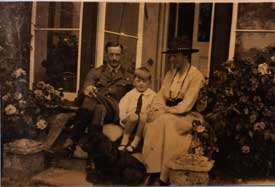
Colonel and Mrs John Belgrave bought West Lodge in 1917. In this photograph, Col Belgrave DSO, Royal Artillery, is seen on homeleave from France with his wife Gwladys and elder son Richard soon after they bought it. Their younger son Robert was born there. Mrs Belgrave was interested in everything that took place in the village. She took the lead in establishing the Piddlehinton Women's Institute. The annual WI flower show, an important village event, was held at West Lodge. She organised the WI classes for learning the craft of rush work and also started a pack of Wolf Cubs which met at West Lodge. She was very keen for the village to have a village hall and at her suggestion the small sum left over from the building of the War Memorial was used to start a Village Hall Fund. She died in 1937.

The Belgrave's car outside West Lodge soon after they moved to the house in 1917
When Colonel Belgrave retired from the army in 1932, he also took an active part in village life as church warden and school manager. He played a leading part in the formation of the Dorset branch of the Council for the Preservation of Rural England and in the running of the British Legion. He invited all Piddlehinton ex-servicemen to an annual Armistice Day dinner at West Lodge. In 1938, he was recalled to the army and established two schools of anti-aircraft artillery in Wales. On his second retirement at the age of 60 in 1942, he joined the Dorset Home Guard, acting as Chief of Staff to its commander, General Sir Henry Jackson of Piddletrenthide. He resumed his village activities and was well known in the village for the prize apples he grew. He took great pleasure in taking baskets of them to the school for the children. On his death in 1955, the house passed to his son Robert who lived there with his wife Susan until his death in 1991.
The Churchills have the longest known connection with Piddlehinton of any family.

They originally came over from Normandy with William the Conqueror. From them were descended not only the John Churchill who bought Muston Manor in 1609 but also the John Churchill who became first Duke of Marlborough and, through him, Winston Churchill.
Over the centuries, many Churchills were baptised, married and buried in Piddlehinton church. Several Churchills of Muston were High Sheriffs of the County of Dorset.

The Rev William Rush Hallett Churchill (right) 1774-1847 (he adopted the middle names), rector of Winterborne Stickland and his wife Martha (left). He inherited this large estate and added to it by buying Black House Farm after Enclosure, also investing in a lot of other property in the village, both farmland and houses. He also owned West Lodge for a short time after forclosing on the mortgage of Stephen Iles and still held land there in 1841. He did not live at Muston Manor but took a great interest in his estates.

Most certainly the Churchills built Muston Manor in the 17th century, but within 80 years they had moved into Dorchester, having bought Colliton, now the site of County Hall. The house continued to be rented by other members of the Churchill family and the original building would probably have looked like this water-colour painting (left) from around 1800. At some time it acquired a ceiling panel from Colliton House and much later a stone fireplace surround from Waterston Manor.
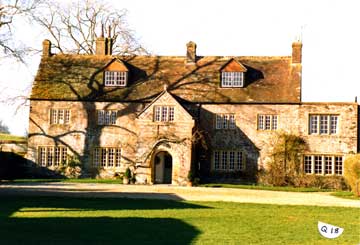
Sometime after the watercolour (above) was painted, the manor was altered and extended. The recent photograph shows the higher roof.
The Churchill family owned Muston Manor until 1901 when it was sold to Clement Tory, although Commander and Mrs Churchill were able to buy the house back again in 1915. They were driving through the valley looking for somewhere to rent before Commander Churchill went on overseas service. They knocked on the door at Muston and Clement Tory readily agreed to them renting, and later buying it. He was not living there himself at the time.
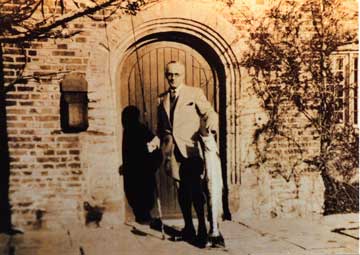

Commander Kenneth Churchill and his wife Margaret lived there with their family for the rest of their lives and became prominent and respected citizens of the village. Commander Churchill was for many years a Church Warden and School Manager. He owned and ran Victoria Park Creamery in Dorchester, now Unigate. His wife, Margaret, was an enthusiastic supporter of the Women's Institute. Among many other activities she organised a home knitting industry in the village. Susan, their daughter, founded the Piddlehinton Brownies in 1940. She married Mark Williams of Bridehead in 1941. Because of the war, their wedding was not in Piddlehinton, as had been that of so many Churchills in previous generations, but in Dorchester, on a Saturday morning. This was so that their many friends could combine coming to it with a Dorchester shopping trip making double use of their scarce war time petrol coupons. Commander and Mrs Churchill's younger son, George, died as a child in 1927. His parents installed the Communion table, reredos, panelling and stalls in the church in his memory.
Their son John sold the house in 1976 after his father's death. It was bought by Mr and Mrs OBN Paine who lived there until approx 2000.
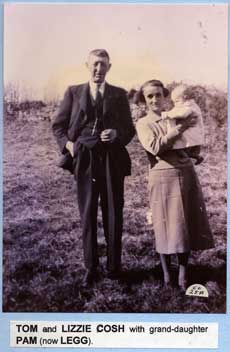
Reg's father Tom Cosh (1891-1968) was quite a character and also worked for the Lovelaces. The Cosh family has been living in Piddlehinton since at least 1820. George Cosh, aged 31 in the 1851 census, was born in Piddlehinton. Tommy Cosh fought in the First World War and served in the Home Guard in the Second World War. As well as working for Mr Lovelace, he was Sexton of the church for 30 years. There is a plaque to his memory in the church. His granddaughter and great-grandchildren live in the village.
Mrs Laura Dyke, with her 5 children, moved to Piddlehinton in 1908 to live in a cottage on the corner of London Row and High Street. Her husband, Albert, had worked for the brewery in Ansty until his death in 1907. Laura Dyke was in her early 40s and to support her family, she helped Parson Newman with his house cows and also helped out at Manor Farmhouse serving milk to the villagers.
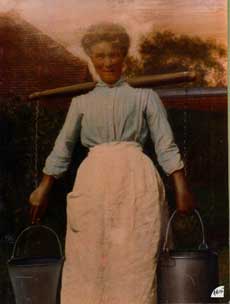
Laura Dyke

Laura Dyke in her garden overlooking Lantern Cottage where her daughter Mabel ran the Post Office and Stores.

Laura Dyke outside her cottage with granddaughter Fay
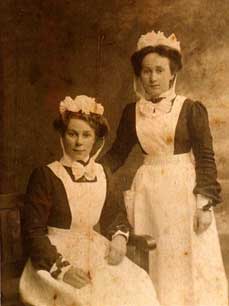
Her 2 eldest daughters, Mabel and Elsie [left], were originally nurses who walked to work along the unmade road to Herrison Hospital.
Mabel married Fred Gerrard and ran the Post Office and village stores. They had one son Jack.
Elsie married her cousin Ern Yeatman and moved away to Surrey. They had 2 children: Reg, who was killed in the Second World War and Laura, who often visited Piddlehinton and now lives here.
Mrs Dyke's younger children were Edward, Gussie and Florrie. Edward and Gussie went to sea. Florrie married local farmworker William Jeanes and made her home in the village with their 3 children Ted, Fay and Terry.
There were other unrelated Dyke households in the village - Charlie Dyke and his wife and daughter Muriel lived in the High Street. Their son Albert was killed in the Second World War.
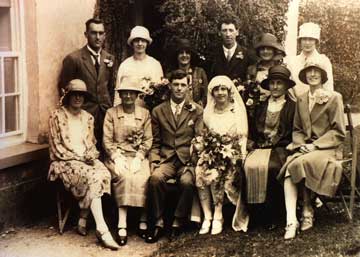
Cyril Green was born in Kingrove House, Piddletrenthide, the youngest son of gamekeeper Harry Green and his wife Harriet. On leaving school, he helped his father farm Hope Farm, Piddletrenthide, being too young to enlist to fight in the war. He married Christobel Chaldecott whose parents farmed at White Lackington. Their first home was Myrtle Cottage but they moved to Bournemouth to run a shop.
Two years later, they came back to Piddlehinton to farm. They rented the Laurels from Eton and leased Kiddles Farm from Colonel Belgrave and Higher Heave Farm as a sub-tenant, from Rex Lovelace. They also took over Hope Farm and eventually White Lackington Farm. These farms totalled 600 acres [242Ha] between them. Animals and machinery all moved between the different farms. They lived for many happy years at the Laurels, eventually buying it from Eton.
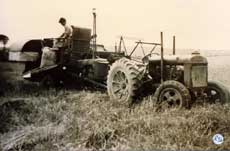

He employed local people on his farms, Percy Teversham was his dairyman and Arthur King, Herbie Trevett and the younger Ivor Spracklen also worked for him. During the war, 2 land girls joined his workforce. Cyril is seen here talking to Barbara, his Land Girl.
The upside-down tractor, rats running from the thresher, and chasing the bull are among the memories of his farming days.
.As well as running his farms, Cyril was both a Parish District Councillor, actively representing the community until shortly before his death in August 1977
Bill Gregory was born at Black House and the family moved to Rectory Road when he was 3 months old. He was one of 9 children. Bill's mother acted as the local midwife, and young Bill was pressed into service as guide during darkness, holding a candle in a jam jar for a lantern to guide her to confinements. His father worked for Mr Mayo at Little Piddle farm; his duties included maintaining the water meadows along the Piddle. Bill used to catch trout and eels stranded when the hatches were opened. Bill worked at Manor Farm for Mr and Miss Riggs until he was 18. then he went into the building trade as a bricklayer. He worked on many local houses. Bill married Emily Woodland in 1932. She had come to live in the village in 1916 when only 8 years old. Her father, Mr Woodland, was a carter. He had a disagreement with his employer, Lady Debenham, at Briantspuddle who required him to work on Sundays, so he sought a new position. He was too late for the hiring fair held in Dorchester each February for a new job starting the following 5th April, so he advertised in the Western Gazette. Mr Walter Lovelace who farmed at East Farm, Piddlehinton, came in a pony and trap, interviewed him and gave him a job as carter.
The Woodlands moved to East Farm Cottages where her parents stayed until her father retired in 1931. They then moved to West Lane (the cottage is now gone). Emily was the youngest of the family of 8 children. She attended the village school until she was 14 years old. The school had some 90 pupils at that time. On leaving school she went into service, first for Canon and Mrs Helps in Puddletown as 'between maid' for £12 per year. 'Between maids' divided their time, in this case assisting the cook and the parlour maid. She later worked as a housemaid at Tolpuddle and for this she was paid £14 per year, three months in arrears. She had to find her own uniform.

Bill and Emily Gregory's Golden Wedding in 1982
In 1932 Bill and Emily Gregory were married. They set up home at No 14 High Street, next to the shop. Their eldest son, John was born that year and the very next day the next door house caught fire, but fortunately the damage was not serious. Bill saw the smoke as he bicycled home from his work in Briantspuddle and was afraid it might be coming from his home. In 1941, when his mother died, Bill and Emily and their family moved to his parents' house in Rectory Road. Bill's brother Charlie lived with them. Two other brothers, Leonard and Bob, also lived in the village with their families but later moved away.
In 1939, Bill joined the LDV (later the Home Guard) where his skill as a bricklayer was put to good use. In 1942 he enlisted in the Royal Engineers and was trained as a stevedore, working in the London docks. During the invasion of Normandy he worked in the Mulberry Harbour, the floating harbour towed to Normandy to land supplies. He later helped build and repair bridges and buildings for the advancing army. When he left the army in 1945 he joined the Reserve. He was a very keen supporter of the British Legion for the rest of his life. He and Emily celebrated their Golden Wedding in 1982.

Another of Mr Rex Lovelace's farmhands in his later years was Jack Groves (Right, with his mother and brother Walter). The Groves family lived in Piddlehinton for many years, first at Muston, where Mrs Groves (senior) worked for the Churchills. They moved to the cottage in Piddlehinton opposite the forge, by the bridge over the mill leat. This burnt down in 1925. They found a cottage at Egypt, Piddletrenthide, later moving to Ivy House (1934). RG (Jack) Groves had fought in the 1914-18 war. He was badly burnt and spent three years in hospital. Before he enlisted, he had worked as a roadman. After the war he became a postman, cycling round the area. It was while he was on his daily rounds that their house caught fire.

As far as we know, Jack Groves was not related to Alfred Groves, the thatcher and hurdler.
Heave Farm (the name Heave is derived from a heap or hillock) was part of the demesne farmland. At this time it was sublet by Rex Lovelace to Cyril Green.
Tom Jeanes Jnr was the other last farming tenant of Eton. Born on 14 May 1894 he farmed about 90 acres [36.5Ha] with his Uncle Tom Jeanes (as had his grandfather William Jeanes before him). The Jeanes family has lived in the village since John Jeanes arrived with his wife Sarah to work on the land. From the census records we know this was before 1841. The holding in 1871 was of 41 acres and 2 men and a boy were employed. They kept sheep and grew corn. The family lived at Whites Dairy House and in the dairy cottages.
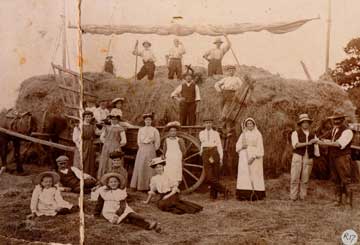
Haymaking was a family occasion in the late 19th century. This postcard was sent to Bess and showed "Uncle Tom's family, with Ern marked with a cross". Uncle Tom was the elder Tom Jeanes. Ern Yeatman, marked with a cross, lived in Surrey but came to Dorset for his holidays to visit his Aunt Laura Dyke and his cousins (one of whom, Elsie Dyke, he later married).
Tom Jeanes Jnr had two brothers and five sisters. One of his sisters, Mabel, married Bert Saint, the carpenter and funeral director. Other sisters moved away. The elder brother Walter was killed in the First World War. Younger brother William returned to work on the Manor Farm and later for Woodsford Farms.
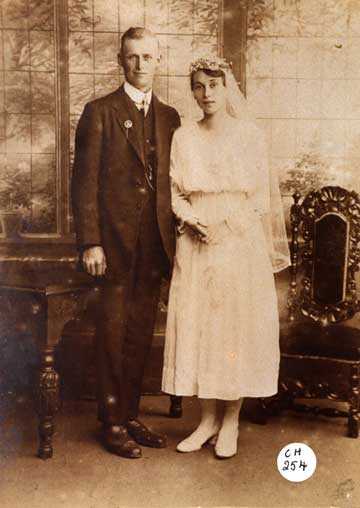
William Jeanes and Florrie Dyke (another of Laura's daughters) were married in Piddlehinton Church in 1920.

Herbie Downton on the tractor, Bill Jeanes on the binder, working for Captain Fellowes on the Manor Farm c1949
Their elder son, Ted, worked as a butcher for Wightmans in Piddletrenthide. He joined the navy during the Second World War. He died in 1965 leaving a widow and children in Dorchester. Younger son Terry and daughter Fay still live in the village and take an active part in village life. Terry was sexton at the church and captain of the bellringers. Fay was married to Geoff Lord (1932-2000), the church organist.
When his Uncle Tom died, Eton passed the tenancy down to Tom Jnr, a bachelor. Terry Jeanes and Joe Damen worked for him. He always kept a barrel of home-made cider in his barn by the churchyard, for social pleasure.

Tom Jeanes with village children including Wilf Saint, Jack Gerrard, Ted Jeanes, Doris and Alfred Barrett
Many men and boys from the village spent time helping him on his farm, as in the days of his uncle.

Harvest time, August 1949, Tom and Terry Jeanes

Tom Jeanes with Jack Gerrard on the horse

Tom Jeanes 1977.
Tom Jeanes retired in 1966, the end of the Eton era! He was the last yeoman farmer to farm in the village! He died in 1978.
Five generations of the Lovelace family have farmed in Piddlehinton. Joseph Lovelace was one of Eton's copyhold tenants in Piddlehinton in the early 19th century. His name first appears as an official in the manorial court in 1836. In 1830 he established one of the first registered flocks of Dorset Down sheep. In the Tithe award of 1838 he is listed as having 5 holdings totalling 152 acres.
By the time of the 1851 census, James Lovelace his son, aged 31, appears as the farmer/miller. Like his father before him he frequently held office in the manorial court. In the 1861 census James is described as farming 560 acres [226Ha] employing 20 men and 8 boys. He and his wife Susan had 8 children aged between 14 and 2 and two servants. In 1858 he is recorded as having been elected a Juror at the manorial court. He probably held this office several times. In the 1861 census he is listed as farming 450 acres employing 12 men, 8 women and 5 boys on a yearly tenancy. By 1881 he was a widower farming 420 acres with 12 men and 3 boys.
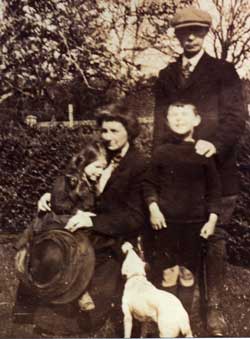
Millicent and Walter Lovelace with their daughter Elneth and their son Rex at East Farm c 1912
Walter Lovelace, his son, took on the tenancy. He was a churchwarden from 1900 until his death in 1927. After his death, the pulpit in the church was given in his memory by the people of the village. On the death of his wife Millicent, many years later, the family gave the gates and lamp arch at the entrance to the church path in her memory.

Mr Frank Woodland, carter to Mr Walter Lovelace, East Farm, 1916-1931, with an old binder. He was reported to steer a strange course on occasions (to avoid worms as he could not bear to run them over!).

Rex Lovelace with son Bill and shepherd John Randall - onetime 'stockman of the year
After his father Walter's death, Rex Lovelace, then a young man, succeeded to the tenancy of East farm. In 1942 he bought the 44 acres [17.8Ha] of Glebe land. After the Second World War he also took over the tenancy of the Manor Farm. He was for some years Chairman of the South Dorset Hunt and also Chairman of the Piddlehinton Parish Council until it merged with other parishes to form the Piddle valley Parish Council in 1977. He died in 1978.
His son Bill, who took on the tenancy, died in 1981. He and his wife Jane exchanged their tenancy for the freehold of part of the property, which she still farms today.
To qualify for a combine harvester in the war, a farm needed 400 acres [162Ha] of corn. Between Rex Lovelace at East Farm and Edgar Tory at Bourne, the requisite total was held. They arranged to share the first Massey Harris combine. It arrived in kit form from Canada for a cost of £1058 plus an extra £80 for the pick-up reel. Reg Cosh used to drive it.
Thomas Meggs was the tenant of Eton's Manor farm for 33 years from 1786 until his death in 1819. In 1794, when he was 54, he joined the Dorset Volunteer rangers, the newly formed force raised privately by Lord Milton, son of the Earl of Dorchester, to defend the county against invasion by Napoleon. They agreed to receive no pay and to clothe and horse themselves, receiving only a sword and a pistol from the government. They undertook to attend training and exercises not more than twice a week and not during harvest or sheep shearing. In 1794 there was a plan for the Prince of Wales to attend an exercise on Muston Down which was cancelled due to a royal death. In 1797 when the danger of invasion increased, Lieutenant Meggs became a captain and raised his own troop. The whole force numbered 380. It was reviewed by King George III with the rest of the corps on Fordington Field in 1798 and again in 1799 and 1801. The king was 'highly pleased and gratified with the whole appearance and performance'. The queen and princesses were present. They were probably on their way to Weymouth, one of the king's favourite resorts. When peace was signed in 1802 the Dorset Volunteer Rangers were disbanded. They were the forerunners of the Dorset Yeomanry.
Thomas Meggs is listed as having held office in the Manorial Court of 1816. He died when he was 83. There is a tablet in the chancel of the church erected to his memory and to that of his wife Susan, who died two weeks after her husband, and to his only son Harry who died in 1821.

Mr and Mrs Riggs with some of their family outside their cottage near the New Inn
Her father, Bill Riggs, had come to Piddlehinton from Chine Hill (between Piddlehinton and Puddletown). He married Mrs Alice Hoskins, a widow living in High Street, whose husband had been killed in the Boer War. Before joining the army, Mr Hoskins had been a postman, walking daily from Piddlehinton to Cerne Abbas with the mail.
On his arrival in the village, Mr Riggs worked for Miss Riggs (they were not related) at Manor Farm but later he worked as groom and gardener for Mr Walter Lovelace. Mrs Hoskins had two young daughters when she married Mr Riggs. The family continued to live in her home for a while. They later moved to a cottage across the bridge by the New Inn, now demolished. They had five more daughters, the youngest of whom, Wyn, married Jack Gerrard, and still lives in the village today.

PC Nick Frisby, the present (1990) Piddle Valley policeman, dressed in a uniform of the time of PC James Searley such as he would have worn.
Her father, Bill Riggs, had come to Piddlehinton from Chine Hill (between Piddlehinton and Puddletown). He married Mrs Alice Hoskins, a widow living in High Street, whose husband had been killed in the Boer War. Before joining the army, Mr Hoskins had been a postman, walking daily from Piddlehinton to Cerne Abbas with the mail.
On his arrival in the village, Mr Riggs worked for Miss Riggs (they were not related) at Manor Farm but later he worked as groom and gardener for Mr Walter Lovelace. Mrs Hoskins had two young daughters when she married Mr Riggs. The family continued to live in her home for a while. They later moved to a cottage across the bridge by the New Inn, now demolished. They had five more daughters, the youngest of whom, Wyn, married Jack Gerrard, and still lives in the village today.
PC James Searley was stationed in Piddlehinton from 1885-1888. He lived in a cottage in the village which served as both home and Police Station. He was a single man who during the course of his duties had to travel miles to other villages and towns. All this was done on foot. Only the superintendents in charge of divisions were required to provide themselves with a horse. The bicycle was not used by Dorset police until 1894; the Dorchester Division possessed just one bicycle. PC 89 was graded as a first class constable, his wages were £1. 3s. 4d. per week. He kept a very interesting Duty Journal - here are just a few quotes from it:
1885
May 29th: Special Duty at Yeomanry reunion at Weymouth by order.
Oct 19th: detected Harry Harwood stealing apples value 6d. the property of Mr. James Lovelace of Piddlehinton.
Nov 9th: Special Duty at Sherborne Election and returned to my station in the night.
1886
March 26th: Apprehended John Jones for begging alms at Piddlehinton and took him to Dorchester.
March 27th: Attended Petty Sessions to give evidence against John Jones for begging. Committed for 14 days hard labour.
June 3rd: Received a complaint from Mr. J. Riggs of Piddlehinton that some person had cut off his cow's tail. Made immediate enquiries and examined the cow and am of opinion that it was not cut off but suffering from tail worm. Reported the particulars to Superintendent Gale.
June 21st: Proceeded from Piddlehinton to Dorchester for drill.
1887
April 30th: To Dorchester to report to Supt. Gale particulars of a fire at Piddlehinton on same date destroying house and furniture the property of Albert Harding. Also did duty before and after the fire.
July 14th: Moved some Gipsies from Waterston Ridge.
August 22nd: Served school attendance summons personally on George Woodward at Lower Waterston.
August 31st: Special duty at Sherborne Flower Show.
Nov 5th: Attended Petty Sessions to give evidence against George and William Larcombe for being drunk in charge of horses and furious driving, fined 30/- each including costs.
Nov 11th: Did duty in the village - there being a concert in the school room.
Other officers living and serving at Piddlehinton until 1926:
- Richard Lane Hann (1863-65)
- Theodore Ironside (1870-1871)
- Joseph Marsh (1871-1873, went on to become Deputy Chief Constable of Dorset)
- Thomas Cooper (1873-1874)
- James Snelling (1884-1885)
- John Matcham (1875-1881, rose to the rank of Superintendent at Sherborne)
- Francis Larcombe (1874-1885)
- James Powell (1882-1884)
- John Chaplin (1881-1882)
- John Shepherd (1892-1895)
- William Pond (1894-1899)
- Walter Bagg (1905-1910)
- Ernest Elsworth (1899-1900)
- George Samways (March 1901-Oct 1901)
- Basil Jay (1913-1919)
- George Clothier (1919-1922)
- Ernest Gale (1922-1926)
Clement Tory bought Muston Manor and its 980 acres of farmland from the Trustees of William Churchill in 1906. Although he did not live in the farmhouse, he took an active part in the farming of the land.


These photographs of steam threshing and binding were taken on Clement Tory's farm about 1918. The Overtine tractor shown here was later buried on land, now part of Lea Farm. Rex Lovelace later dug it up to retrieve the large water tank, but the rest remains buried to this day.

When Clement Tory died on 4th February 1940 he left 2700 acres stretching from Dorchester to Melcombe Horsey, including Muston, Alms and Bourne Farms. All the land was sold off and this advertisement from the Dorset County Chronicle on August 15 1940 shows its location. It sold for £7 an acre. Clement Tory's sons Philip and Edgar bought part of the estate at Piddlehinton, Edgar Tory buying Bourne farm (which he and his wife Freda, farmed for 23 years). Philip Tory married Nancy Lovelace and they lived at Mulletts, just over the boundary into Piddletrenthide. Edgar later bought Philip's land.


Doles Wood Plantation, where these photographs were taken in the 1950s, was bought by Clement Tory and when sold to a Mr Pentelow in 1940 it made £325. Edgar Tory bought it back five years later for £1 more! The first combine harvester was bought during the Second World War. To qualify for a combine 400 acres of corn had to be cultivated; Rex Lovelace and Edgar Tory between them had the required acreage and together they bought a Massey Harris for £1058 and paid an extra £80 for the pick-up reel. It arrived in boxes from Canada and was assembled by Reg Cosh who also drove it. It was petrol driven and needed two people to operate, one behind the driver was the 'bagger' who had to place and remove bags from 4 outlets - two for the main corn, one for tailings and one dustbag. One time this dust ignited and the combine caught fire. After 6 years Edgar bought out Rex's share and the combine eventually finished its days in the trees at Doles Wood.
From 1944 the boys from Poole Grammar School helped with the harvest, the Torys were issued with pots, pans, blankets etc to help cater for them. Enough barley was cut to make 41 ricks, these were thatched. Sam Stockley was the hedger and thatcher.
Mrs Tory can remember the water meadows being maintained and used. Using a system of hatches the rivers were dammed in the early spring and the flooding filled the ditches, allowing early grass to grow. Puddletown was renowned for its water meadows and those in the 'Puddletown' parts of Piddlehinton are far superior to the others.

The Shooting Party - The Tory Family in Kingcombe, Doles Wood, in 1932. L-R Philip Tory, Elneth Tory, Nancy Loveless, Blanche Tory (Wife of Clement), Brian Needham, ?, ?, Clement Tory in bowler hat as usual.
Clement Tory bought Muston Manor and its 980 acre farm from William Churchill in 1906. Although he did not live in the house, he took an active part in farming the land. He was a very keen hunting man. He died in 1941. Many of the mourners at his funeral wore hunting dress, and earth from a fox sanctuary was sprinkled on his grave. After their father's death, two of his sons, Edgar and Philip, took over Bourne Farm and Alms Farm respectively, both of which had been part of their father's Muston property.

Philip Tory and Nancy Lovelace's wedding in Piddlehinton.
Philip married Nancy Lovelace, sister of Rex and daughter of Walter Lovelace. They continued farming in Piddlehinton for a few years living at Mulletts, just over the boundary into Piddletrenthide, before moving away.
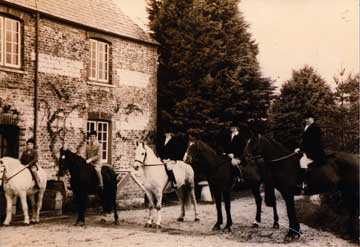
Edgar had known Bourne Farm all his life, coming over there often with his father from their home at Sturminster Marshall. He bought it and came to live in the village of Piddlehinton with his new bride Freda in 1941. He later bought his brother's adjacent land (Alms Farm) as well. Edgar and Freda farmed at Bourne for 23 years and raised their three daughters there. The photograph is from 1958.
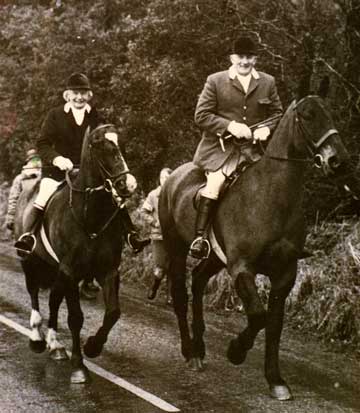
In 1964 they sold Bourne Farm to Mr Ingram Spencer of Hanford Farms and moved to Higher Waterston where they farmed a smaller acreage. Although outside the parish boundary, they kept their connection with Piddlehinton. Edgar Tory served as a ChurchWarden from 1972 until his death in 1989. He was a Joint Master of the South Dorset Hunt from 1965 to 1980. He was a keen sportsman and naturalist and knew all the country around Piddlehinton like the back of his hand. Seen here with Freda Tory out hunting with the South Dorset Hounds.
Five generations of the Way family ran the blacksmith's business from the 1830s until the 1940s. George Way was born in Tolpuddle in 1799. He brought his wife and three children from Puddletown (where their youngest son James was born in 1827) to settle in Piddlehinton. As a master blacksmith, George employed two hands. James Way became a blacksmith journeyman, and at least two of his five sons, John and Alfred, entered the family trade. John was apprenticed in 1871, aged 15 and presumably took on the responsibility of the village forge on the death of his grandfather George on 10th March 1874. Alfred became a blacksmith journeyman like his father (in the 1881 census, aged 17).
John and his wife Emma also had three daughters, Kate, Agnes and Rose. All three of them became pupil teachers at Piddlehinton School at the turn of the century and went on to train as teachers. Rose Way returned to Piddlehinton School as assistant teacher in 1907, teaching the infant class. She was very musical and was the church organist for 29 years. She helped train the choir and taught local children to play the piano. She played a very active part in village life. She ran the Youth Club and taught the members folk dancing. She was for many years president of the Women's Institute. She formed and ran an adult theatrical group 'The Bright Sparks' who put on various entertainments. They were in great demand and performed in many other places as well as Piddlehinton.

John Way [Left] died in 1927. The newspaper report of the time says

His son Fred [Right] , also followed the family tradition. The smithy was always a great fascination to the villagers. There was always someone looking over the half door watching the horses being shod. Fred Way, in his time, would chase the children with his hammer. It was all in good fun and the air was filled with shrieks of laughter.
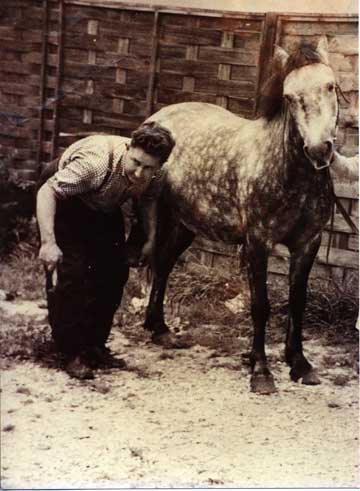
Another of Fred Way's sons, Jack [Left], became the last blacksmith in the village. Fewer horses were kept as the farms became mechanised in the 1940s. Jack Way adapted his business by turning to work on cars.
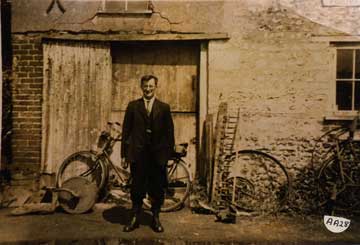
Fred Way's son Bill [Right] outside the forge in the 1930s.
Some of the family still lives locally.
Ann Winzer (née Keats) 1794-1873
(Nb. Her surname is spelt both Winzer and Winzor on her headstone, which is in Piddlehinton graveyard!)
Ann was born in Fordington, Dorchester, in 1791 according to her gravestone, but as she was baptised in 1795 it is more likely that she was actually born in 1794.
At aged 17, she married James Winzor in 1811 and they quickly had a son, James - who unfortunately died aged about 5 and was buried in Fordington in 1817.
James (Senior) was a soldier in one of the Light Dragoons Regiments stationed in Dorchester and was posted abroad to fight at Waterloo and in Paris.
Ann accompanied him and acted as a nurse to the wounded at the battle of Waterloo in 1815, many years before Florence Nightingale's famous days pioneering the nursing of the sick and wounded in the Crimean War.
After returning to England to collect James (junior), she also looked after the sick in Gibralta before returning to Dorchester with the family.
Ann had a scond son, Joseph, who was baptised in 1824 and worked wih his father for a while before moving away. He had an illegitimate daughter, Carloine Collins, in 1853 and later moved back to live with his parents in Dorchester. Sometime after 1861 James, Ann, Joseph and Caroline moved to Piddlehinton. It appears that James was one of the many Chelsea Pensioners who did not live at the Royal Hospital, Chelsea, as it seems that Colonel Astell, who came to live at West Lodge in 1862, took steps to ensure that Ann also got a pension in recognition of her service to the army. He also employed Caroline as a housemaid.
In the census of 1871, both James & Joseph give their professions as a plasterer journeyman.
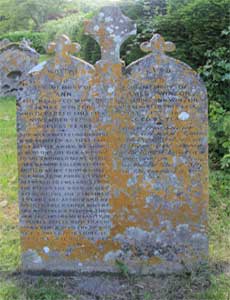
Ann died in 1873 and is buried in Piddlehinton churchyard. Her tombstone near the north boundary tells her story. Her husband died two years later.
"SACRED TO THE MEMORY OF ANN THE BELOVED WIFE OF JAMES WINZER WHO DEPARTED THIS LIFE NOVEMBER 28TH 1873 AGED 82 YEARS"
"She was a Waterloo heroine who assisted at that famous battle AD 1815 by aiding & assisting the sick & wounded. She endured many hardships having followed the British army from Brussels to Paris. From Paris to Duney. Returned to England & from thence to the Rock of Gibraltar where she remained 4 years. She afterwards resided in this parish where she received a pension through the instrumentality of Colonel Astell with that of many other officers by whose kindness this stone is raised as a tribute of respect to a long life spent in true & faithful service."
Mr Frank Woodland came to the village in 1916. He had a disagreement with his employer, Lady Debenham, at Briantspuddle who required him to work on Sundays, so he sought a new position. He was too late for the hiring fair held in Dorchester each February for a new job starting the following 5th April, so he advertised his services in the Western Gazette. Mr Walter Lovelace who farmed at East Farm, Piddlehinton, came in a pony and trap, interviewed him and gave him a job as carter.
The Woodlands moved to East Farm Cottages where her parents stayed until her father retired in 1931. They then moved to a cottage in West Lane (no longer standing). Emily was the youngest of the family of 8 children. She attended the village school until she was 14 years old. The school had some 90 pupils at that time. On leaving school she went into service, first for Canon and Mrs Helps in Puddletown as 'between maid' for £12 per year. 'Between maids' divided their time, in this case assisting the cook and the parlour maid. She later worked as a housemaid at Tolpuddle and for this she was paid £14 per year, three months in arrears. She had to find her own uniform. In 1932, she married Bill Gregory and they lived in Piddlehinton for the rest of their lives.